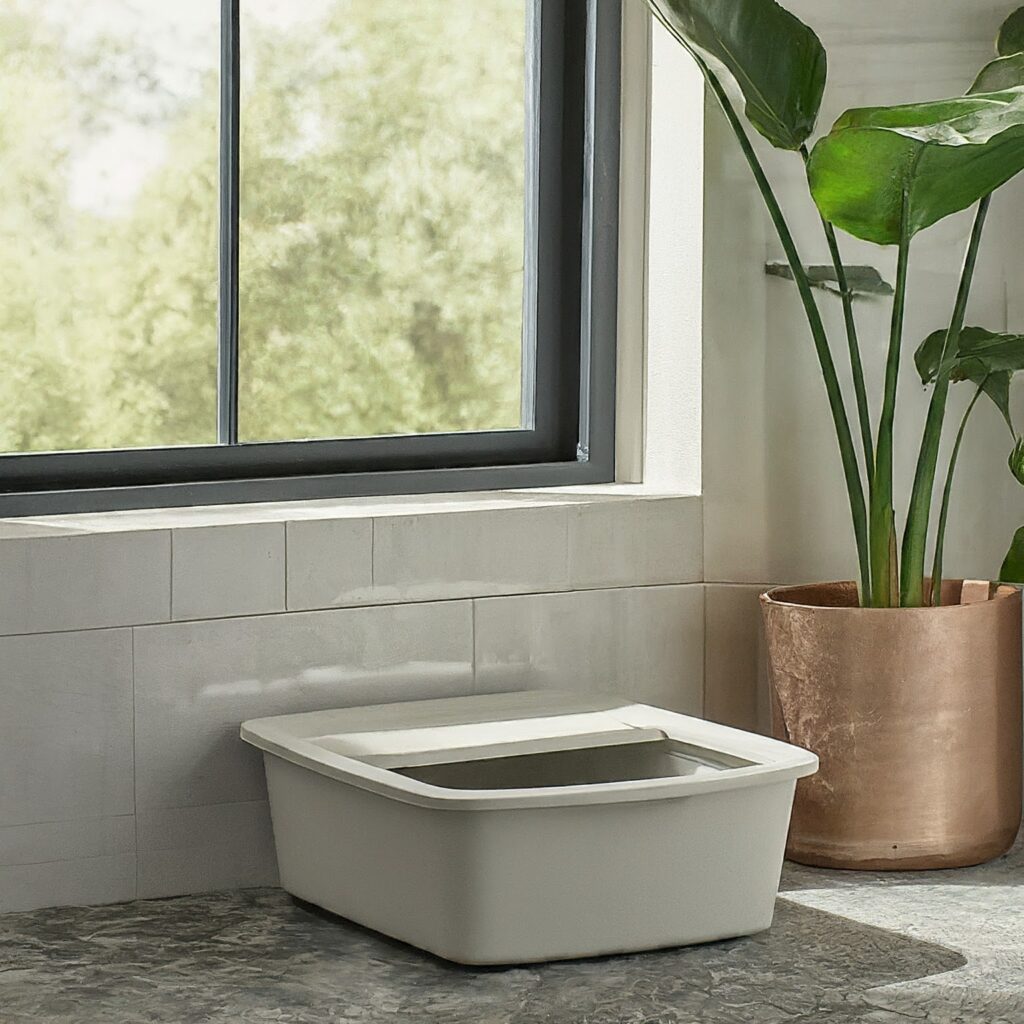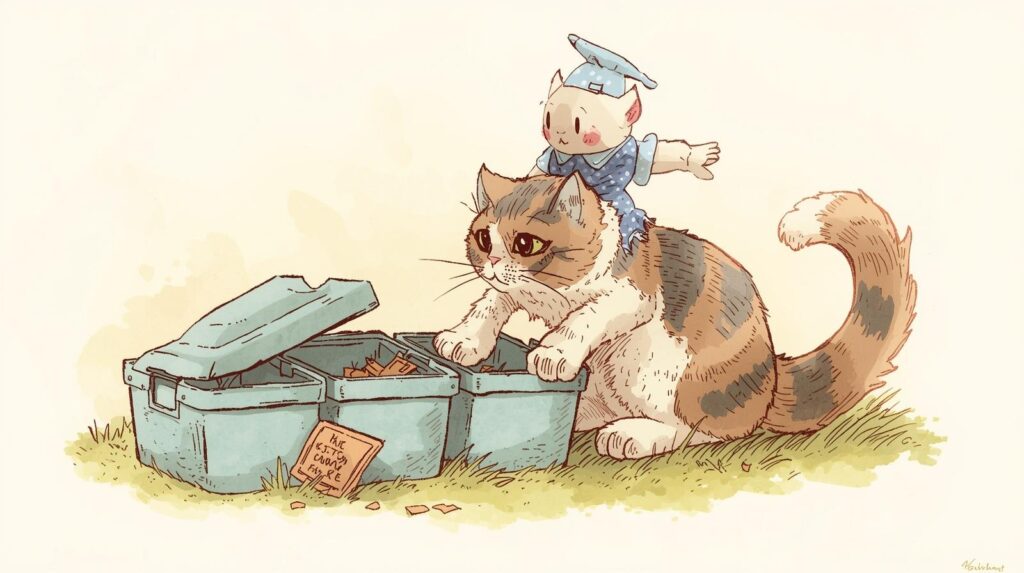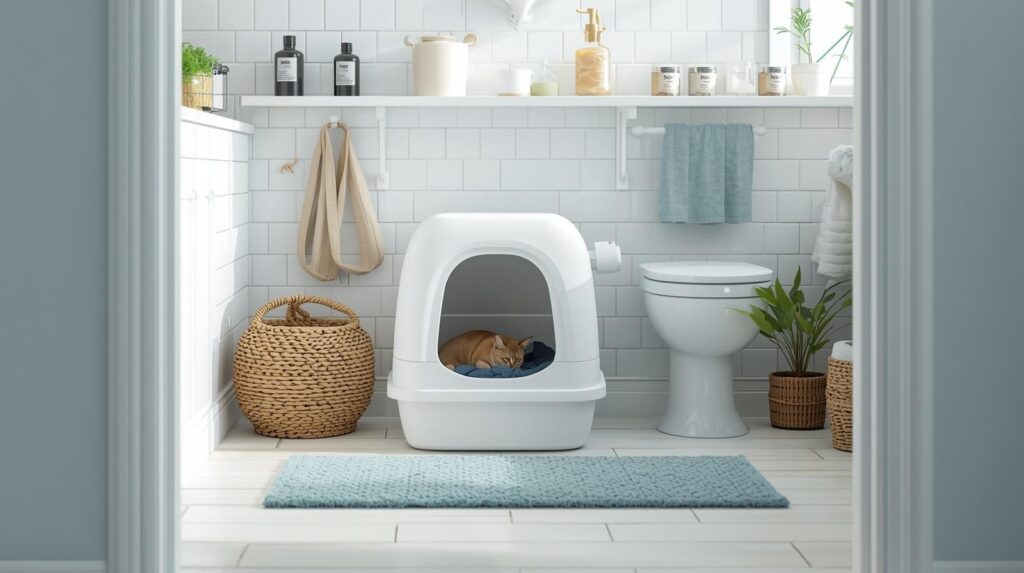
If you just found tiny insects crawling around your litter box — don’t panic. You’re not alone, and it doesn’t mean you’re a “bad pet parent.” Most new cat owners using natural or eco-friendly litter notice these pests at least once, because organic litter holds a little moisture, and that becomes a magnet for cat litter bugs over time. At first, they look harmless and easy to ignore… until more start appearing around the box, the floor, and sometimes even near your cat’s fur or tail.
The good news? This problem is fully fixable — and once you understand why these bugs show up, you can stop them before they spread or turn into a bigger hygiene issue. Vets say bugs are not just about “dirt” — they’re almost always a sign of moisture, organic material, or trapped odor.
In a moment, we’ll break down exactly which bugs you might be seeing and why they show up in the first place… because identifying the right bug is the first step to kicking them out for good.
Now let’s uncover what kind of bugs you’re really dealing with — and why they chose your litter box.
Table of Contents
What Kind of Bugs Are in My Cat’s Litter Box (and Why They Appear)
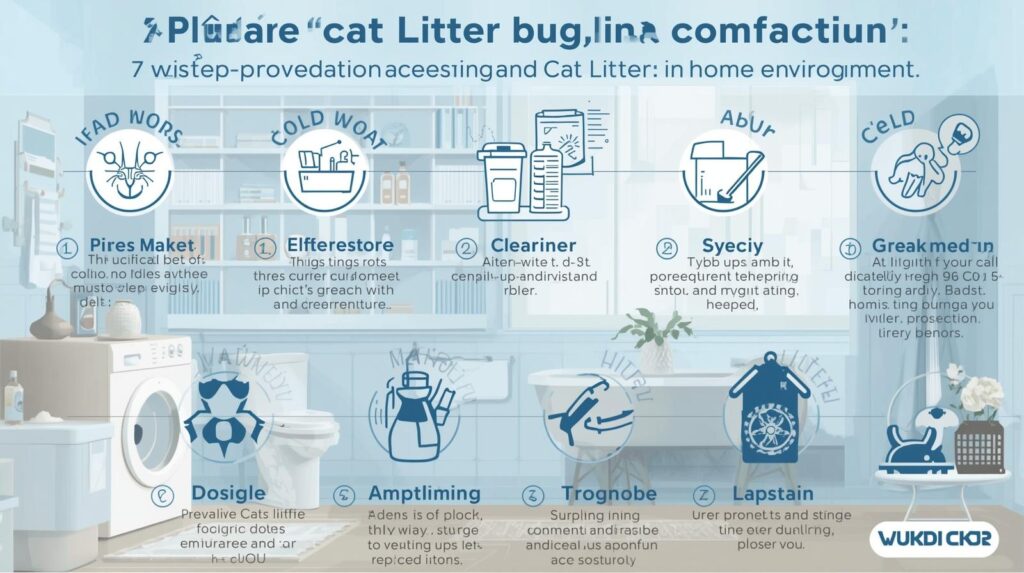
Not all cat litter bugs are the same — and knowing which one you’re dealing with helps you fix the problem faster. Most of the time, these tiny insects are attracted by moisture + organic material, especially in eco/plant-based litters like corn, wheat, wood, walnut shell, or grass seed. These natural litters smell like food sources to small insects, which is why they show up even in clean homes.
Below are the most common bugs found in or around a litter box:
1. Fruit Flies / Fungus Gnats
These are the most common. They look like tiny black dots flying around the box or hovering near corners. They are drawn to moist plant-based litter and leftover urine odor.
Why they appear:
Because organic litter holds moisture → perfect breeding spot.
2. Springtails (Tiny White Jumping Bugs)
Very small, white or gray, and they jump like tiny fleas. They love damp surfaces, especially in humid homes or bathrooms with low ventilation.
Why they appear:
Humidity + damp litter = ideal habitat.
3. Litter Mites
Microscopic, usually white/beige, crawling inside the litter grains. They are especially common in grain-based litter (corn/wheat) because it can contain natural food dust that insects feed on.
Why they appear:
Organic particles behave like stored “pantry food” for mites.
4. Beetle Larvae / Pantry Moth Larvae
Sometimes litter arrives from the manufacturer with hidden eggs (rare but possible with plant-based products). These eggs hatch once the bag is opened.
Why they appear:
They came from the litter itself, not your home.
5. Ants or Cockroaches
These show up when the litter box is placed near the kitchen, feeding area, or damp storage corners. They follow odor trails.
Why they appear:
They’re searching for warmth + food scent residue.
Why This Matters (Vet Logic)
Vets confirm that bugs aren’t “dirty house” problems — they are moisture and scent problems. Even a perfectly clean home can develop cat litter bugs if:
- The room is humid
- Litter stays damp
- The litter is organic/plant-based
- The box is covered and traps steam
And this is exactly why Section 3 will focus on climate + humidity — because 80% of infestations start there without owners realising.
How Climate & Humidity Make Cat Litter Bugs Worse (Reality Check)
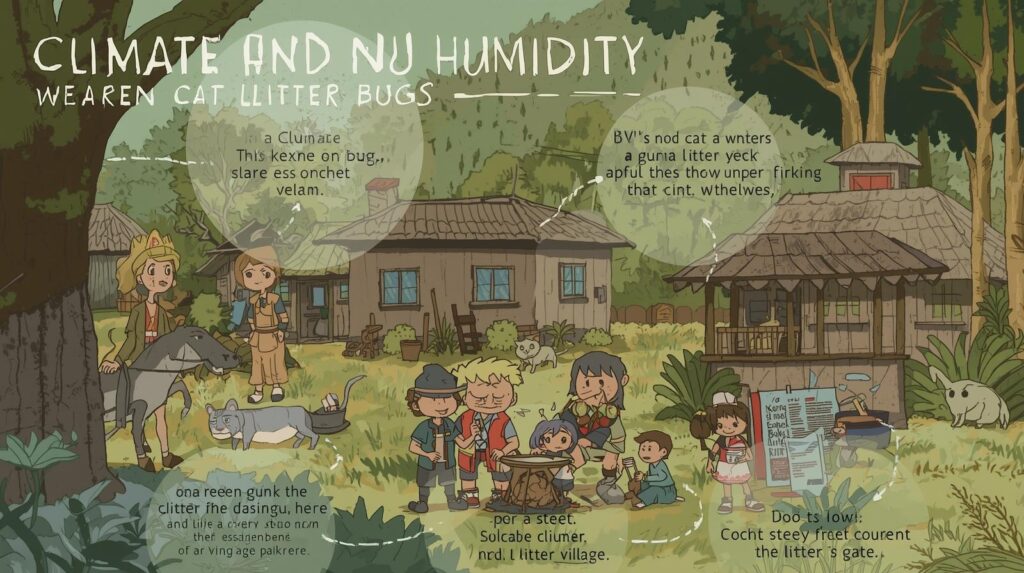
Many cat parents don’t realise that bugs don’t just appear because of “dirty litter” — they appear because of moisture, and moisture is controlled by your home’s climate, not cleaning alone. Warmth + humidity create the ideal breeding zone for cat litter bugs, especially when using eco or plant-based litter.
Below are the top climate triggers and how they silently invite insects:
1. High Humidity (Rainy seasons/bathrooms / closed rooms)
Problem: The air stays damp, so the litter never fully dries.
Why it happens: Moisture = breeding ground for fungus gnats, mites, and springtails.
Mini Fix: Place the litter box in a well-ventilated corner, not a steamy bathroom or laundry room.
2. Warm indoor temperatures
Problem: Heat speeds up insect hatching cycles.
Why it happens: Many bugs (especially gnats and mites) reproduce 2–3x faster in warm rooms.
Mini Fix: Keep litter area cooler — a small fan or open window can break the cycle.
3. Low airflow in apartments
Problem: Stale air traps humidity and odor inside the box.
Why it happens: Covered litter boxes + closed rooms = “bug greenhouse.”
Mini Fix: Choose a ventilated or open-top litter box when using organic litter.
4. Plant-based litter absorbs humidity like a sponge
Problem: Natural fibres (corn, wheat, wood) retain moisture.
Why it happens: Bugs mistake organic litter for decomposing food.
Mini Fix: Mix plant-based litter with a small amount of silica or clay to reduce dampness.
5. Climate change = more indoor pests (2025 reality)
Problem: Longer humid periods globally = higher insect survival indoors.
Why it happens: Warmer winters allow bug eggs to survive year-round.
Mini Fix: Switch to daily quick scooping + weekly deep clean during humid months.
Which Litter Types Attract the Most Bugs (And Which Are Safest?)
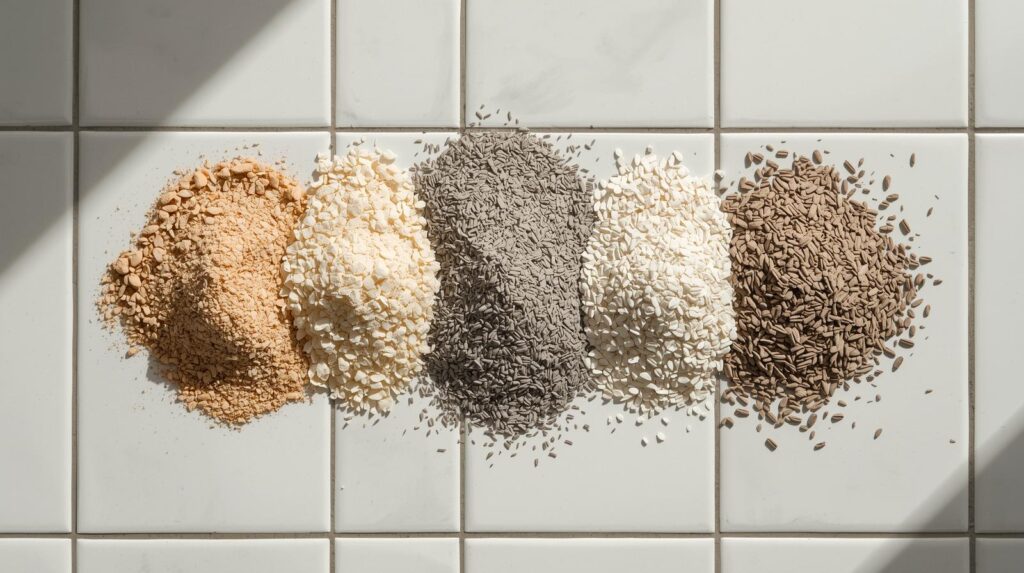
Not all litters attract insects in the same way. Some hold moisture longer, some contain organic dust that feeds larvae, and others stay too dry for bugs to survive. The difference helps you pick a litter that prevents cat litter bugs instead of feeding them.
Bug Risk Comparison Table
| Litter Type | Bug Risk Level | Why Bugs Like / Avoid It | Best For |
|---|---|---|---|
| Corn / Wheat | High | Organic, holds moisture, smells like food | Natural fibres attract gnats & mites |
| Walnut / Grass Seed | High | Less moisture than grain, but still organic | Soft texture lovers |
| Wood Pellets | Medium | Less moisture than grain but still organic | Mild eco choice |
| Recycled Paper | Medium | Absorbs moisture, slow drying | Low-tracking homes |
| Clay (Clumping) | Low | No food source + dries faster | Most bug-resistant |
| Silica Crystals | Eco users have but highest bug risk | Ultra-dry = bugs can’t survive | High-humidity homes |
Why Eco/Plant-Based Litters Attract Bugs the Most
Problem: These natural litters come from organic crops — insects treat them like mini compost or old grains.
Why it happens: Bug eggs can survive inside grain-based litter and hatch when moisture + heat are present.
Micro Fix: Rotate or mix with clay/silica during humid months.
Covered Litter Boxes = “Bug Traps”
Problem: The lid traps warmth and steam inside.
Why it happens: Damp air = fungus gnat paradise.
Micro Fix: Use an open-air or partially vented box in the summer/rainy season.
Wrong Room Placement = Fastest Infestation
High-risk spots:
- Bathroom (humidity)
- Kitchen (ant/cockroach scent trails)
- Balcony / near plants (gnats hitchhiking from soil)
Better spots:
- Dry corner with airflow
- Room with a window/fan
- Away from food & water bowls
Storage Mistake People Don’t Realise
Even unused litter can attract pests if the bag is left open. Some bugs hatch inside storage sacks (especially corn/wheat) before the litter ever reaches the box.
Micro Fix: Transfer unused litter into a sealed plastic bin, not a soft bag.
In short: litter choice + humidity + storage = 80% of bug problems solved before they even start.
How to Get Rid of Litter Box Gnats & Crawling Bugs (Step-by-Step Fix)
If you’re already seeing tiny flies, mites, or crawling insects, don’t worry — you can remove them quickly without harsh chemicals. Below is the vet-approved, 2-layer method that works even during heavy infestation:
STEP 1 — Remove Moisture (The #1 Bug Magnet)
What to do: Dump all used litter + wash the box with hot water.
Why this works: Bugs (especially gnats + mites) cannot survive without moisture.
Bonus tip: Dry the box completely before refilling — even a damp corner keeps eggs alive.
STEP 2 — Natural Safe Repellent (Home-Remedy Layer)
Use white vinegar spray (50/50 with warm water) around edges and corners where bugs hide.
- Safe for cats
- Breaks bacteria’s smell that attracts insects
- Prevents eggs from hatching
Let sit for 10 minutes → then wipe dry.
STEP 3 — Fast/Direct Bug Removal (Speed Layer)
For flying gnats/fruit flies:
Use a small apple cider vinegar trap placed near but NOT inside the litter box.
How to make it:
- 1 small bowl
- ACV + a drop of dish soap
- Cover with cling wrap + poke small holes
This traps adult gnats within hours.
STEP 4 — Starve Remaining Bugs (Dry Litter = No Habitat)
Refill the box with low-moisture litter (clay or silica) for at least 7–10 days.
Bugs die off when moisture disappears.
If you prefer eco litter, mix 80% regular + 20% organic temporarily until the humidity drops.
STEP 5 — Stop Reinfestation from Surroundings
Bugs hide along:
- Baseboards
- Corners
- Under mats
- Around water bowls
Wipe these areas once with vinegar solution — not bleach (bleach fumes irritate cats).
STEP 6 — Room Airflow Reset
Just opening a window or keeping a small fan running breaks the humidity cycle → no bug breeding.
Even vets say:
“Airflow does more for bug prevention than odor-control litters.”
STEP 7 — Weekly Quick “Bug-Proof” Routine
This takes 30 seconds but blocks future infestations:
- Scoop twice a day
- Stir litter to keep it dry
- Wipe edges with dry cloth
- Keep box uncovered at least part of the day
This single habit prevents cat litter bugs better than sprays or chemicals.
Natural Repellents That Actually Work(Proven to Reduce Bugs)
Most people try random “home remedies” from YouTube or TikTok — lemon spray, cinnamon dusting, bay leaves, etc. Sadly, 80% of these don’t stop cat litter bugs, and some are even toxic to cats.
Below are vet-approved, cat-safe repellents that actually keep gnats, mites, and tiny crawling bugs away from litter areas.
1. Food-Grade Diatomaceous Earth (FG-DE)
| Feature | Benefit |
|---|---|
| Natural powder made from fossilized algae | Harmless to cats when food-grade |
| Dehydrates bugs on contact | Fast and long-lasting protection |
| Odorless | Good for sensitive cats |
How to use:
Sprinkle a very thin layer around the outside base of the litter box, along walls, and under mats. Do NOT create a dusty cloud near your cat’s nose.
2. Apple Cider Vinegar Bug Trap
| Feature | Benefit |
|---|---|
| Cheap DIY | Works for gnats/fruit flies |
| Attracts and traps bugs | Prevents swarming |
How to use:
Place a small jar with ACV + 2 drops dish soap near (not inside) your litter area. Replace every 48 hours.
3. Catnip & Rosemary Sachets (Natural Repellent Plants)
Some bugs hate the scent of catnip + rosemary (but cats love catnip).
Best for: Fleas, mites, crawling litter bugs.
How to use:
• Put dried sachets near the box
• Replace odor every 2–3 weeks
• Safe even if your cat sniffs it
4. Activated Charcoal Bags
These reduce odor, and when odor goes down → bugs reduce.
Place:
- Behind the litter box
- Inside the storage cabinet
- Near the trash/bin where dirty litter goes
5. Neem Oil (Diluted)
Neem is a natural insect deterrent — but must be properly diluted.
How to use safely:
Mix 1 teaspoon neem oil + 1 cup water, spray ONLY around the outside litter area — never inside the tray.
Natural Remedies to Avoid (Not Safe for Cats)
| ❌ Remedy | Why Unsafe |
|---|---|
| Tea tree oil | Toxic to cats |
| Peppermint essential oil | Respiratory irritation |
| Citrus oils sprayed directly near litter | Strong scent → litter aversion |
| Strong vinegar misting inside box | Strong vinegar misting inside the box |
Vet-Approved Deep Cleaning Method
Even if you remove the bugs once, they will come back if eggs are still hiding around the litter area, the floor cracks, or trash cans. That’s why vets recommend a deep-clean routine — but not with harsh chemicals that scare cats away.
Here’s a step-by-step vet-approved method to clean safely and break the bug life cycle completely:
Step-by-Step Deep Cleaning Routine
| Step | What To Do | Why It Works |
|---|---|---|
| 1 | Empty litter box completely (discard outdoors, not inside bin) | Removes active bugs + eggs |
| 2 | Wash tray with unscented dish soap + warm water | Keeps smell neutral for cats |
| 3 | Rinse with diluted white vinegar (1:4) | Kills bacteria + odor source |
| 4 | Dry fully before refilling | Moisture attracts gnats/mites |
| 5 | Add baking soda under the litter (thin layer) | Odor control → fewer bugs |
| 6 | Replace scooping tools or sanitize weekly | Eggs stick to scoops/rakes |
| 7 | Clean floor and wall edges around litter box | Bugs hide in corners |
Best Cleaning Frequency
| Type of Litter | Deep Clean | Scooping |
|---|---|---|
| Clumping | Every 2 weeks | Daily |
| Non-Clumping | Weekly | 2x daily |
| Natural/Plant-Based | Weekly | Daily |
Tip: Best Natural Cat Litter: A Guide for Cat Owners, if not cleaned regularly.
Where to Clean (Most Owners Forget These Spots)
| Commonly Ignored Area | Why It Attracts Bugs |
|---|---|
| Underside of litter box | Moisture + dust buildup |
| Floor seams or cracks | Tiny egg clusters |
| Trash bin storing dirty litter | Warm + dark = bug nest |
| Scoop holder | Residue sticks to plastic |
| Behind the litter mat | Food crumbs/dust buildup |
Myth vs Fact (Quick Guide)
| Myth | Reality |
|---|---|
| “Strong fragrances keep bugs away” | They usually push cats AWAY from litter instead |
| “Bleach = best cleaner” | Bleach damages cat lungs + worsens ammonia smell |
| “If box looks clean, it’s clean” | Eggs & larvae are microscopic |
Preventive Setup – How to Make Your Litter Area Bug-Proof (Permanent Fix)
Once you remove the bugs, the real protection comes from your setup — airflow, moisture control, placement, and storage style. A clean area + dry surroundings = no breeding ground.
Below is a vet & pest-control–approved setup that keeps your home bug-free long-term.
Where to Place the Litter Box (Best vs Worst Spots)
| Spot | Good or Bad? | Why |
|---|---|---|
| Bathroom (well-ventilated) | Good | Moisture drains, easy to clean |
| Laundry room | Good | Besides kitchen trash |
| Near a window (vented) | Good | Airflow stops bug nesting |
| Under sink/cabinet | Bad | Dark + humid = bugs breed |
| Besides the kitchen trash | Away from the kitchen/pantry | Food smells attract bugs |
| Basement corners | Bad | Cold + damp = mites + gnats |
Proper Ventilation = Fewer Bugs
Gnats and mites thrive in stagnant air. A tiny fan or open window can reduce bug activity by 40–60%.
Best options:
- Small desk fan facing outward
- Window cracked open near box
- Dehumidifier if room is closed
Humidity Control (Secret Step Most Owners Skip)
Bugs lay eggs faster in moisture. Ideal humidity near litter area = 45% to 55%.
| Tool | Benefit |
|---|---|
| Small dehumidifier | Stops mites + gnats |
| Silica gel packs near storage | Prevents moldy litter bags |
| Charcoal bags | Reduces smell + dampness |
Keep Fresh Litter Stored Correctly (Bugs LOVE open bags!)
| Storage Type | Bug Risk |
|---|---|
| Open bag left on floor | Very High |
| Plastic bin with loose lid | Medium |
| Airtight bin (locking) | Low |
| Small refill containers | Open bag left on the floor |
DIY Bug-Proof Layout (Simple Visual)
[Ventilation Source / Window]
↓
┌───────────────────┐
| Litter Box |
| + Rubber Mat |
└───────────────────┘
↓ (Air Flow)
[Small Fan or Dehumidifier]
[Closed Container for Fresh Litter → Stored 2–3 ft Away]Vet-recommended product suggestions
- Dr Elsey’s Ultra Premium Clumping Cat Litter: Recommended by vets for strong clumping, minimal dust. Supports moisture control, which helps prevent bug breeding.
- Arm & Hammer Clump & Seal Cat Litter: Excellent odor and moisture sealing, which reduces the kind of dampness that attracts pests.
- Ökocat Original Premium Clumping Wood Cat Litter: Eco-friendly wood fibre litter; still clumps well and produces less dust—good compromise for your eco/litter-choice persona.
- Purina Tidy Cats Lightweight Free & Clean Clumping Cat Litter: Lightweight clay option, good for households wanting easier handling plus solid clumping.
- World’s Best Cat Litter Original Corn‑Based: Biodegradable corn-based litter for eco-users.
- Pretty Litter Silica Crystal Cat Litter: Silica crystal litter absorbs moisture very well (low-moisture = fewer bugs) though higher cost; good for high-humidity homes or multi-cat setups.
- Fresh Step Advanced Extreme Clumping Cat Litter: Charcoal-enhanced for stronger odor & moisture control; aligns nicely with the prevention strategy.
- Feline Pine Original Cat Litter: Natural pine pellet/meal type—good eco choice but needs careful storage and moisture control because plant-based = higher bug risk.
Further readings
Why Is My Cat Peeing Outside the Litter Box?
Can you bring cat litter on a plane
FAQ on Cat Litter and Bugs
Can I put baking soda in cat litter?
Yes — you can safely sprinkle a small amount of baking soda into the litter to help neutralize odors. But don’t use too much, because cats have a sensitive sense of smell and heavy scents may cause litter box avoidance. A thin layer mixed under the litter is ideal.
Baking soda also helps reduce dampness, which means fewer moisture-loving pests and a lower chance of cat litter bugs returning.
What smell do cats absolutely hate?
Cats strongly dislike citrus (orange, lemon, lime), strong mint, and vinegar-based smells. These can be used around the litter box (never directly in it) as natural insect deterrents, but strong scents inside the box can deter the cat from using it at all. Always apply repellents to surrounding areas — not in the litter itself.
What should you not clean a litter box with?
Avoid using bleach, ammonia, or heavy perfumed cleaners. These chemicals react with urine residue and release irritating fumes. They also mask scent markers, confusing your cat and causing toilet avoidance.
Instead, vets recommend mild unscented soap, enzyme-based cleaners, or diluted white vinegar (only on the outside — never saturate litter).
What is the golden rule for litter boxes?
The golden rule is:
Number of cats + 1 extra litter box.
For example, 2 cats = 3 litter boxes.
More boxes = better hygiene = less moisture build-up = fewer insect infestations.
What are the first signs of toxoplasmosis?
Early signs may include lethargy, fever, diarrhea, swollen lymph nodes, and loss of appetite. Most indoor cats are exposed through dirty litter, raw prey, or contaminated surfaces. Bugs that feed on or crawl through dirty litter can carry particles to other surfaces — one of the many reasons you should quickly control cat litter bugs.
What is the 3-3-3 rule for cats?
This rule explains how long it takes a cat to settle in a new home:
3 days to decompress
3 weeks to learn the routine
3 months to fully bond
This is important for bug prevention because stressed cats may urinate more frequently or outside the box, increasing moisture pockets that attract pests.
How often should you scoop a litter box?
At least once daily, and in humid regions or eco-litter homes, twice daily is best. The longer moisture sits in waste, the faster flies, fungus gnats, and mites appear. Fast scooping = zero food source for pests = no cat litter bugs.
Wrapping It All Up: Keeping Your Cat’s Kingdom Bug-Free
Bugs don’t start in the litter box — they start with moisture.
Once humidity, urine residue, or organic scent builds up, small insects see the litter as a perfect breeding ground. The good news? With the right setup, litter choice, placement, and cleaning schedule, you can stop cat litter bugs before they ever appear.
Remember the 3 essentials:
| Core Preventive Pillar | Why It Matters | Bug Impact |
|---|---|---|
| Dryness | No moisture = no breeding | Stops gnats, mites, larvae |
| Hygiene | Less odor = less attraction | Cuts pest food sources |
| Ventilation | No trapped humidity | Stops hidden colonies |
If you’re already seeing cat litter bugs, don’t panic — it’s fixable. Switching litter materials, improving airflow, sealing unused litter, and maintaining daily scooping are often enough to break the pest cycle within days.
- Clay or silica = lower bug risk
- Eco/plant-based = great for cats, but needs careful storage
- Open, ventilated box > covered box (for moisture control)
- Quick cleaning habits = pest-free litter

